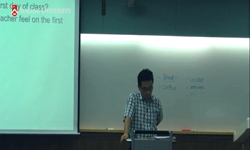본 연구는 한국어 대화에 나타난 말 끼어들기 현상의 유형을 분류하고 말 끼어들기가 일어난 후의 발화 양상에 대해 고찰함으로써 대화 참여자들 사이에 부정적인 것으로만 여겨졌던 말 끼...
http://chineseinput.net/에서 pinyin(병음)방식으로 중국어를 변환할 수 있습니다.
변환된 중국어를 복사하여 사용하시면 됩니다.
- 中文 을 입력하시려면 zhongwen을 입력하시고 space를누르시면됩니다.
- 北京 을 입력하시려면 beijing을 입력하시고 space를 누르시면 됩니다.
부가정보
국문 초록 (Abstract)
본 연구는 한국어 대화에 나타난 말 끼어들기 현상의 유형을 분류하고 말 끼어들기가 일어난 후의 발화 양상에 대해 고찰함으로써 대화 참여자들 사이에 부정적인 것으로만 여겨졌던 말 끼어들기가 실제 대화를 분석한 결과 대화 내에서 긍정적인 역할도 수행한다는 것을 밝히는 것을 목적으로 한다. 본 연구에서는 한국어 대화에 나타난 말 끼어들기의 분석을 위해 21세기 세종계획 현대 국어 구어 전사 말뭉치의 일상 대화와 주제 대화를 연구 대상으로 한다.1장에서는 연구의 필요성 및 목적을 언급하고 연구 방법에 대한 대략적인 소개를 한다. 또한 본 연구의 대상이 되는 21세기 세종계획 현대 국어 구어 전사 말뭉치에 대한 소개와 더불어 말뭉치의 전사 방법에 대해 살펴보았다.2장에서는 본 연구에 필요한 이론적인 틀에 대해 살펴보았다. 우선 기본 개념이 되는 대화분석과 말 끼어들기에 대한 정의 및 유형에 대한 기존 연구를 살펴보고, 본 연구에 맞게 재구성한 분석의 틀을 제시하였다. 본 연구에서는 말 끼어들기에 대한 다양한 정의 및 시각에 대해 ‘한 사람이 이미 말을 시작한 상태에서 다른 사람을 동시에 말을 시작하는 것’을 의미하는 이원표(2001)의 정의를 토대로 다시 하위 유형들을 분류하였다.3장에서는 말 끼어들기의 유형을 말 끼어들기를 하는 화자의 의도성에 따라 청자반응신호(backchannels), 우발적 말 끼어들기, 우호적 말 끼어들기, 비우호적 말 끼어들기의 4가지 유형으로 분류하였다. 말 끼어들기가 대화의 흐름에 방해가 되는 부정적인 것으로 여겨졌던 것과는 달리 한국어 대화에서 나타난 말 끼어들기는 ‘우호적 말 끼어들기’가 가장 빈번하게 출현하여 구어 말뭉치에서 발견된 말 끼어들기 유형 중 절반이 넘는 것으로 확인되었다. 다시 말해, 말 끼어들기가 대화 참여자들 사이에 대화 참여도를 높이고, 긴밀성을 높이는 역할을 한다는 것을 입증하게 되었다.4장에서는 말 끼어들기 현상이 일어난 후에 대화 참여자들이 어떤 방식으로 다시 대화를 이어나가는지에 대한 발화 양상을 Kennedy & Camden(1983)의 다섯 가지 유형을 바탕으로 살펴보았다. 말 끼어들기 후에 대화를 이어나가는 양상은 크게 ‘발화의 지속, 주제의 재도입, 다시 말 끼어들기, 협력하기, 말순서 상실’로 나눌 수 있는데, 한국어 대화에서 ‘말순서 상실’은 거의 발견되지 않는 유형 중에 하나임을 확인할 수 있었다.5장에서는 본 연구의 내용을 정리하고, 앞으로의 말 끼어들기에 대한 연구는 단순히 대화의 구조에 대한 언어학적인 연구를 넘어서서 의사소통의 방법으로서 말 끼어들기를 전략적으로 사용할 수 있도록 좀 더 다양한 상황에서의 연구가 필요함을 제시하고 있다.
다국어 초록 (Multilingual Abstract)
This study aims to classify the types of phenomena known as interruptions that take place in Korean conversation and inquire into utterances that take place after the interruptions, and through this reveal the positive role that interruptions, general...
This study aims to classify the types of phenomena known as interruptions that take place in Korean conversation and inquire into utterances that take place after the interruptions, and through this reveal the positive role that interruptions, generally considered by participants in a conversation to be negative, play in conversation through the results of analysis on real conversation. For analysis of interruptions in Korean conversation, this research has used daily conversation from the 21st-century Sejong Project's Korean spoken corpus dictionary and theme-based conversation as its subjects.The first chapter references the necessity and goal of the research, and gives a general introduction to the methods of research. It also gives an introduction to the 21st-century Sejong Project's Korean spoken corpus and takes a look at the dictionary methods used in the corpus.The second chapter takes a look at the necessary theoretical framework of the research. First, this research paper inquires into conversation analysis and interruptions that makes up its basic concepts and existing research on definitions and types, and presents a framework of restructured analysis of the issue. On the variety of definitions and views of interruptions, this research categorizes their types based on Lee Won-pyo's definition of them as being 'when one person begins talking after another person has begun talking'.In the third chapter, forms of interruptions are categorized into four types, in accordance with the intent of the speaker doing the interruption; that is, backchannels, inadvertent interruptions, favorable interruption, and unfavorable interruptions. In contrast to the negative view of interruptions as being an impediment to the flow of conversation, the most frequent type of interruptions that took place in Korean conversation were of the favorable type, and over half of the interruptions found in the spoken corpus were confirmed to be of the same nature. In other words, interruptions were shown to have carried out a role in raising the participation rate between those taking part in a conversation, and increased closeness.The fourth chapter investigates how participants in a conversation continue a conversation after an interruption has occurred, based on the five types of utterances according to Kennedy & Camden (1983). The types of phenomena that occur in a conversation after an interruption has occurred are divided broadly into the following: continuing of the interruption, returning to the subject, interrupting again, cooperation, and losing one's turn; in Korean conversations the last phenomenon, losing one's turn, was the one of the phenomena that was hardly present.The fifth chapter summarizes the research and shows the need for research in more varied situations in order to get past the linguistic research seeing interruptions as mere parts of conversation structure, in order to be able to use interruptions in a strategic manner as a method in communication.








